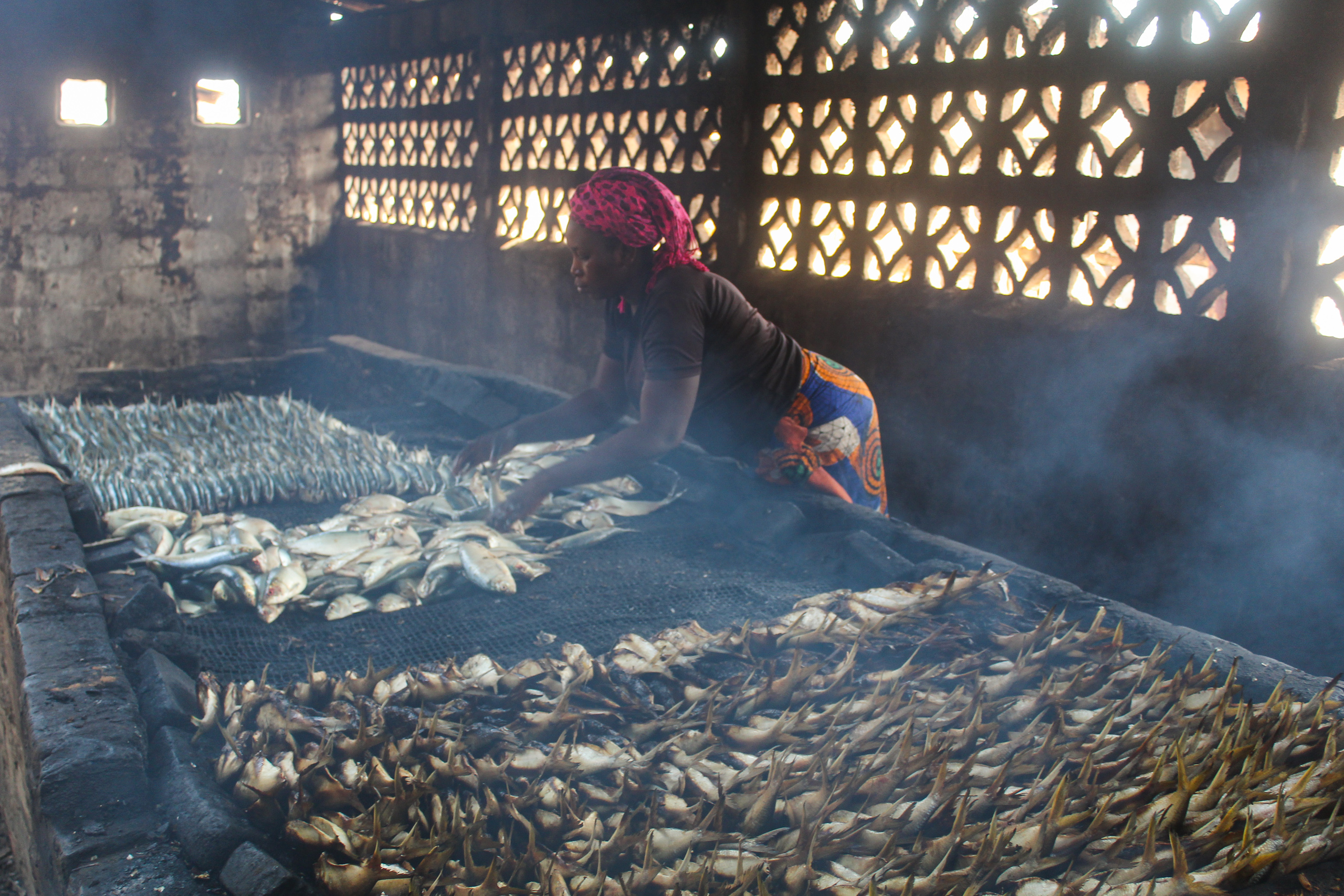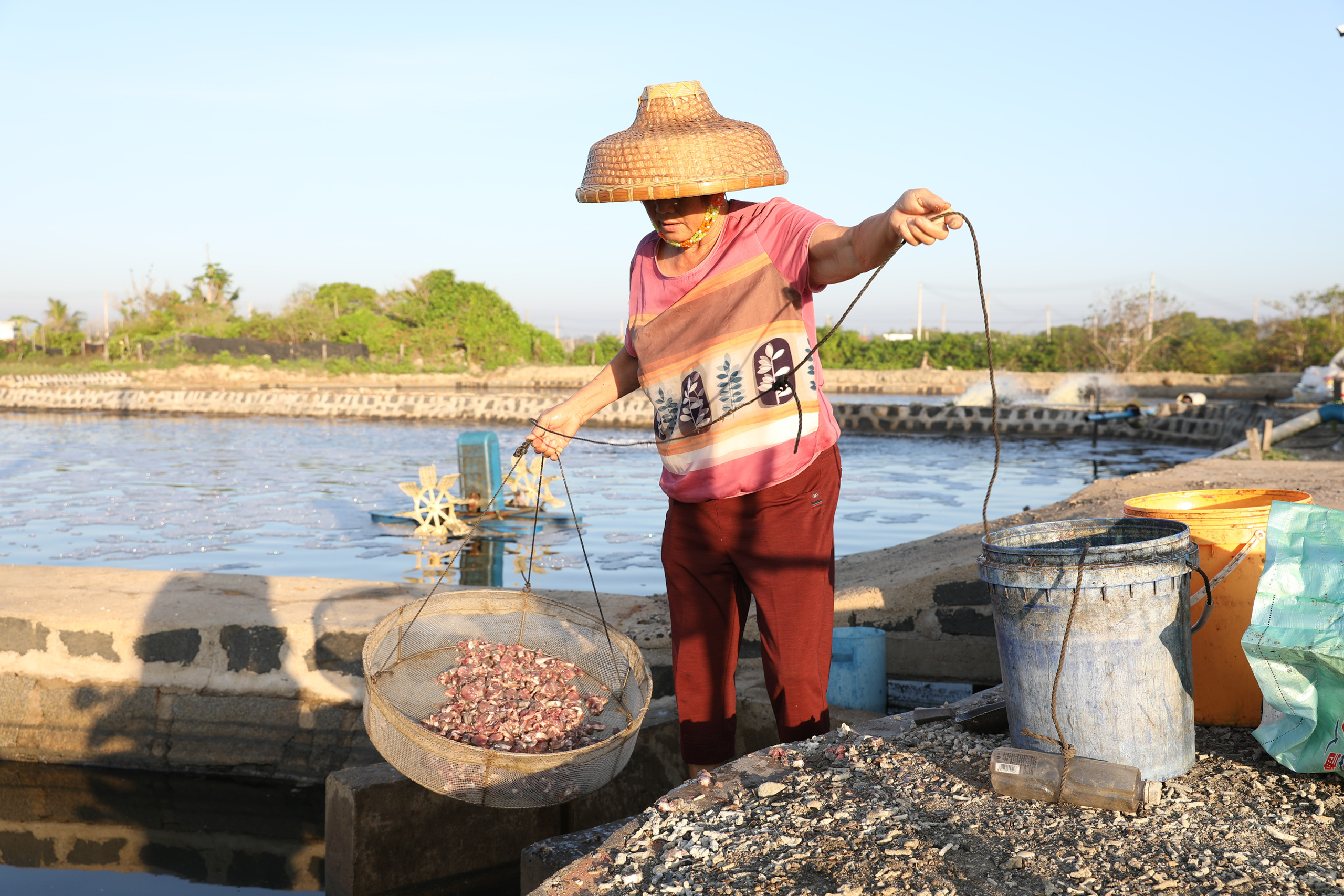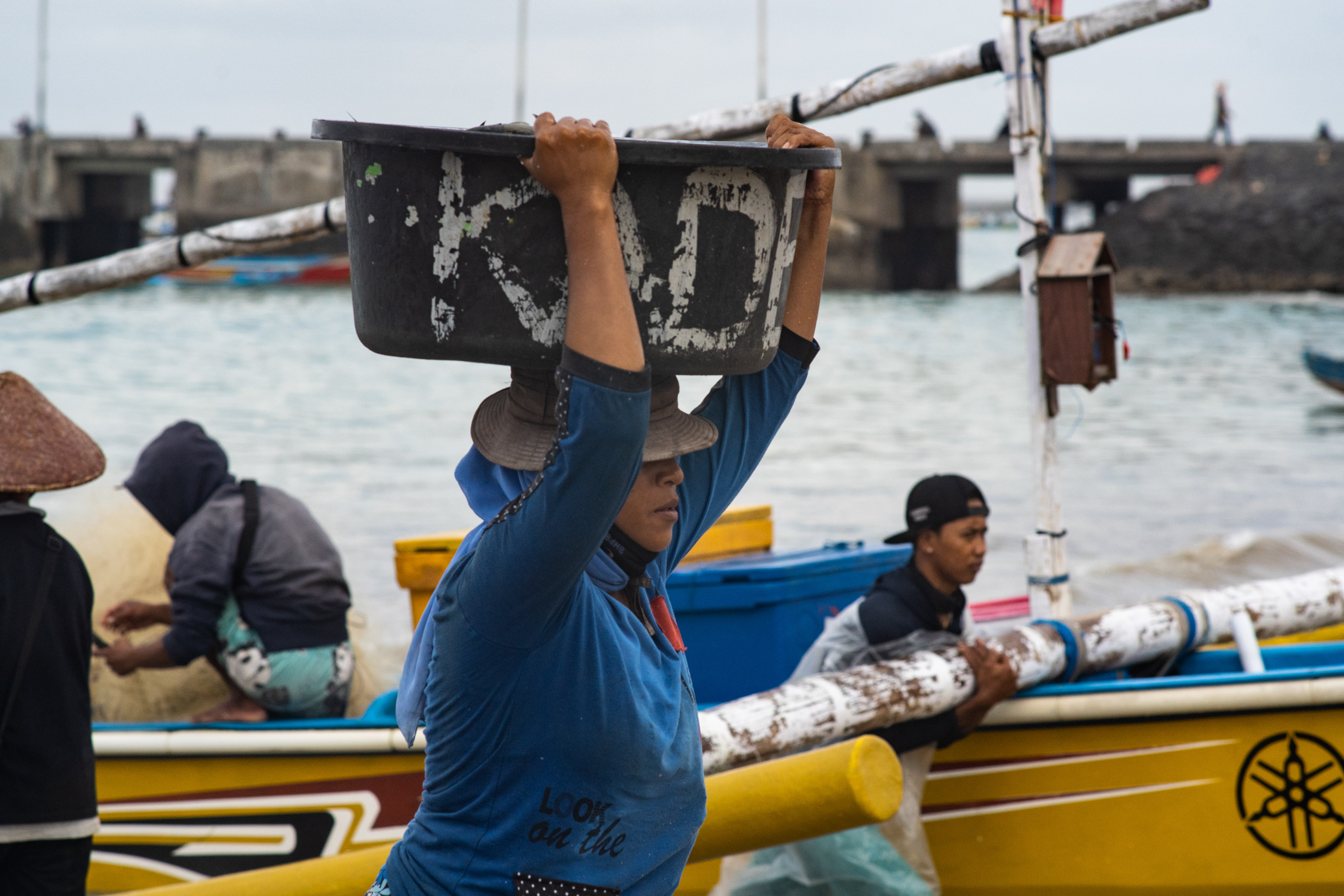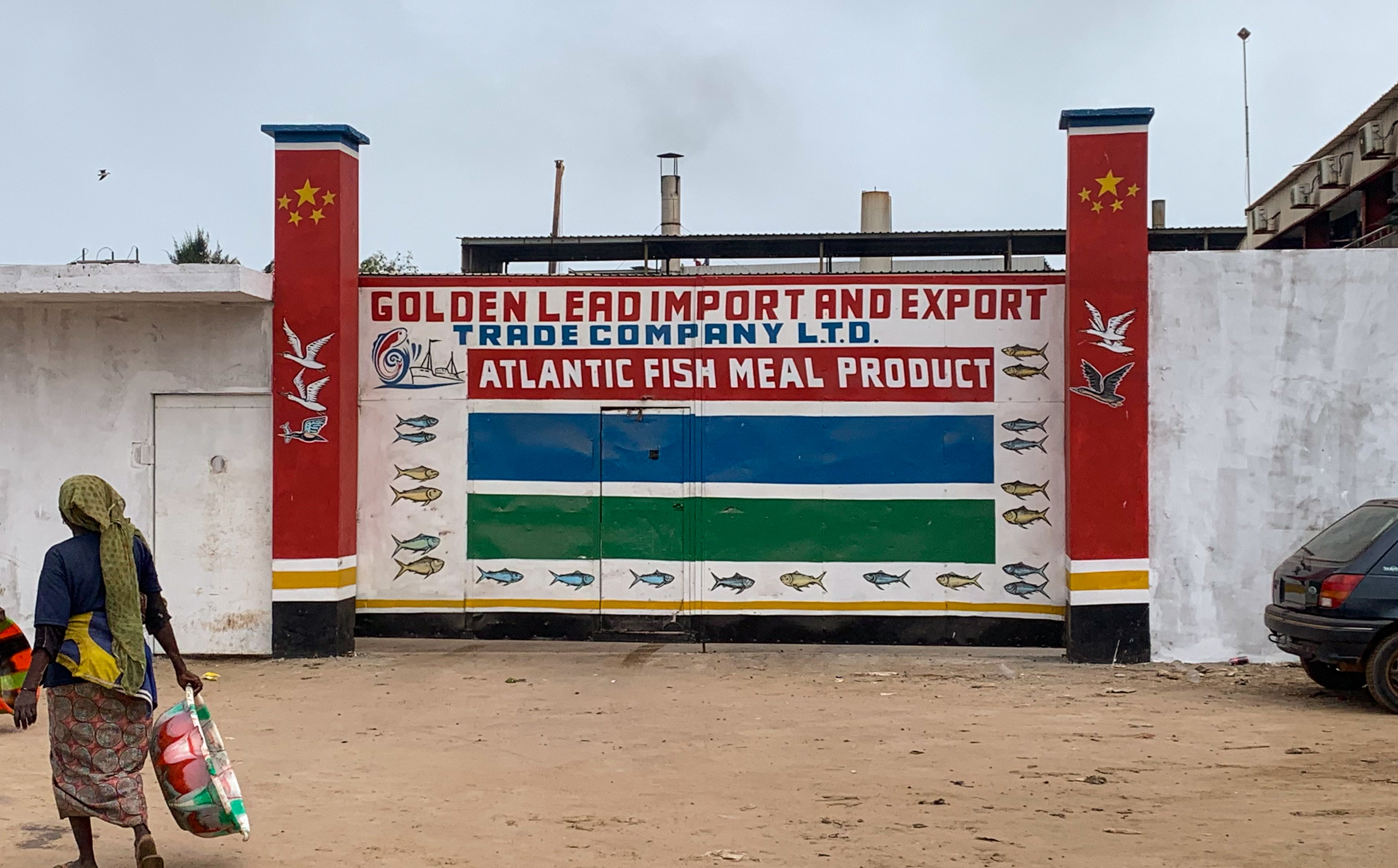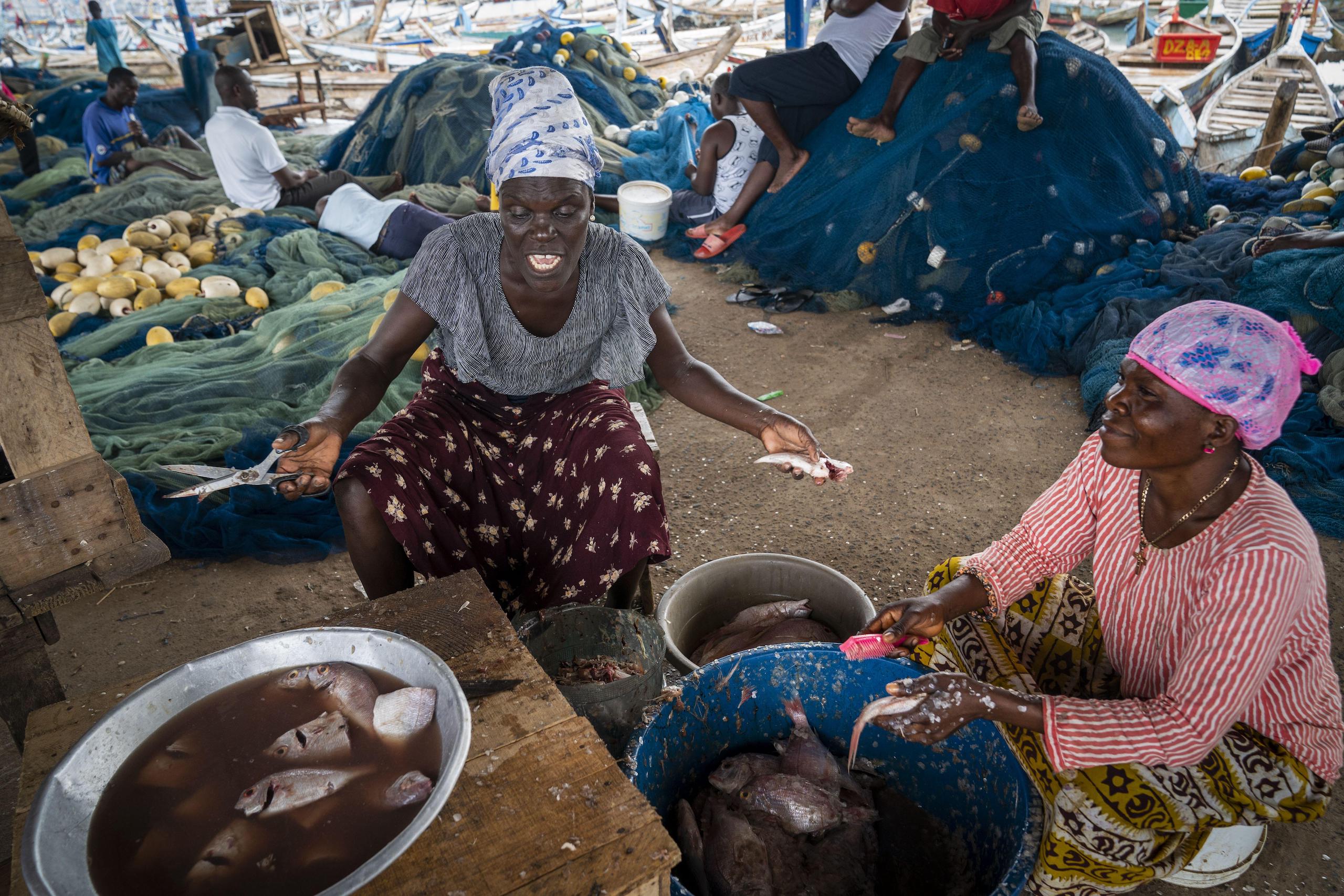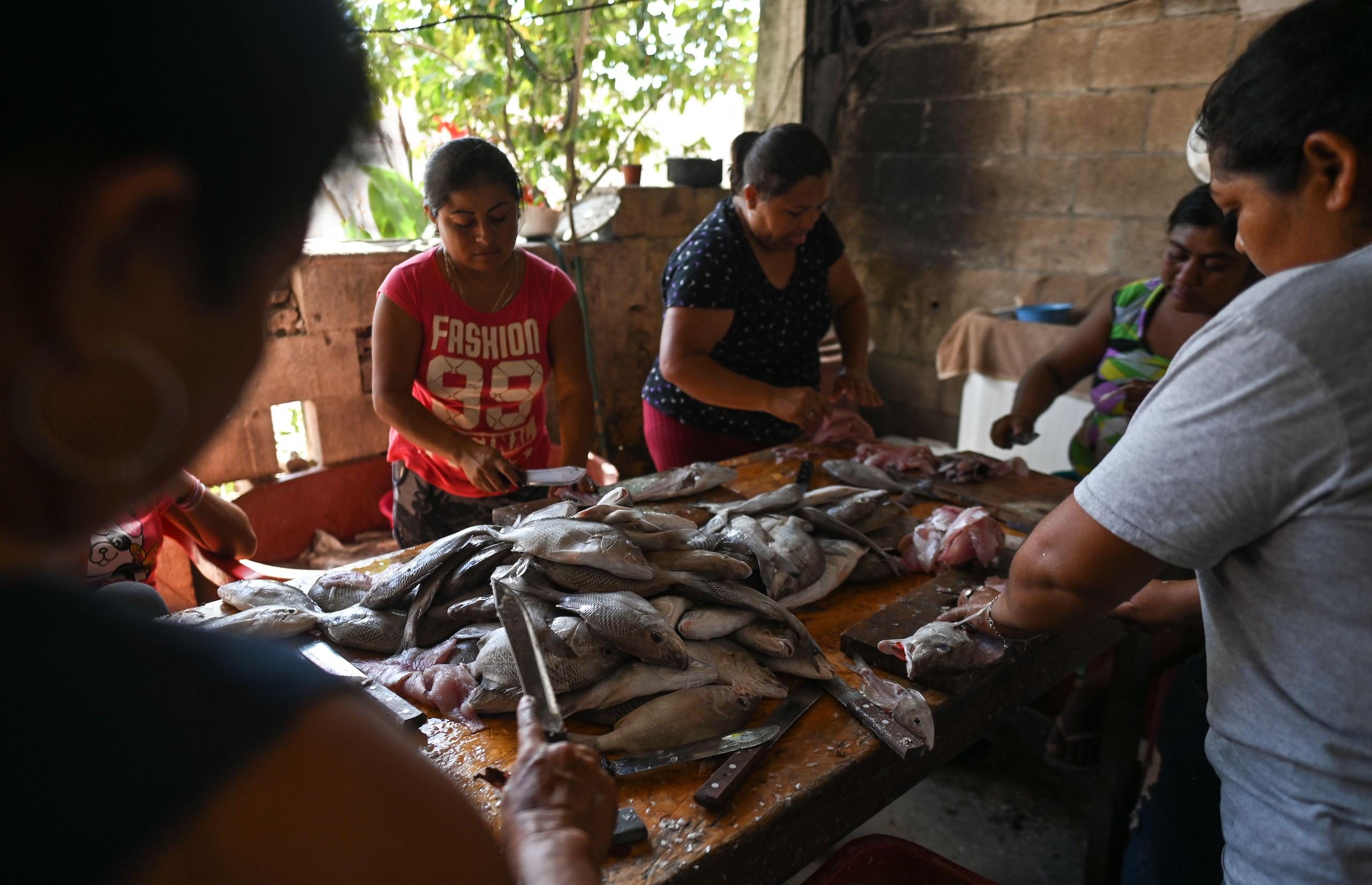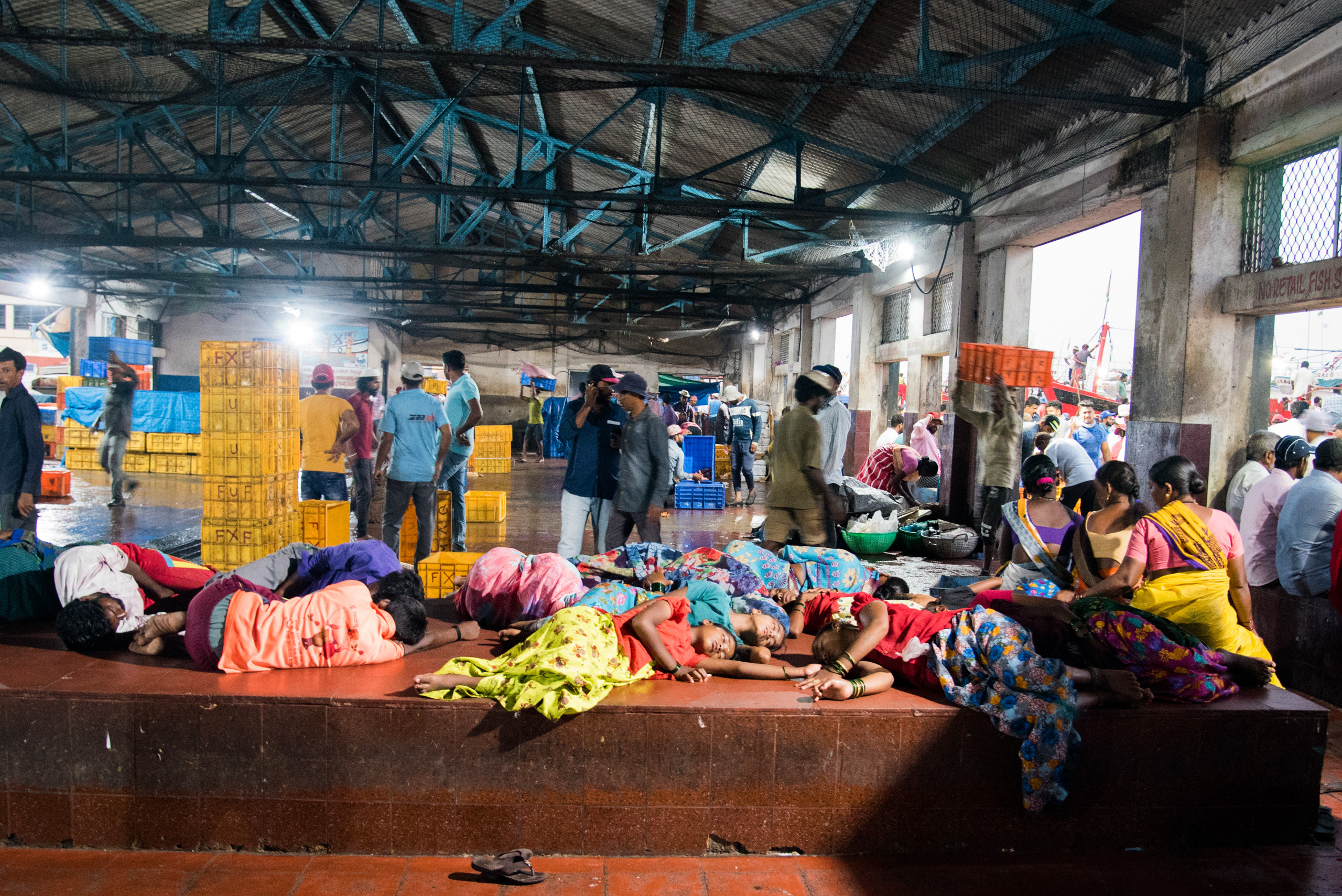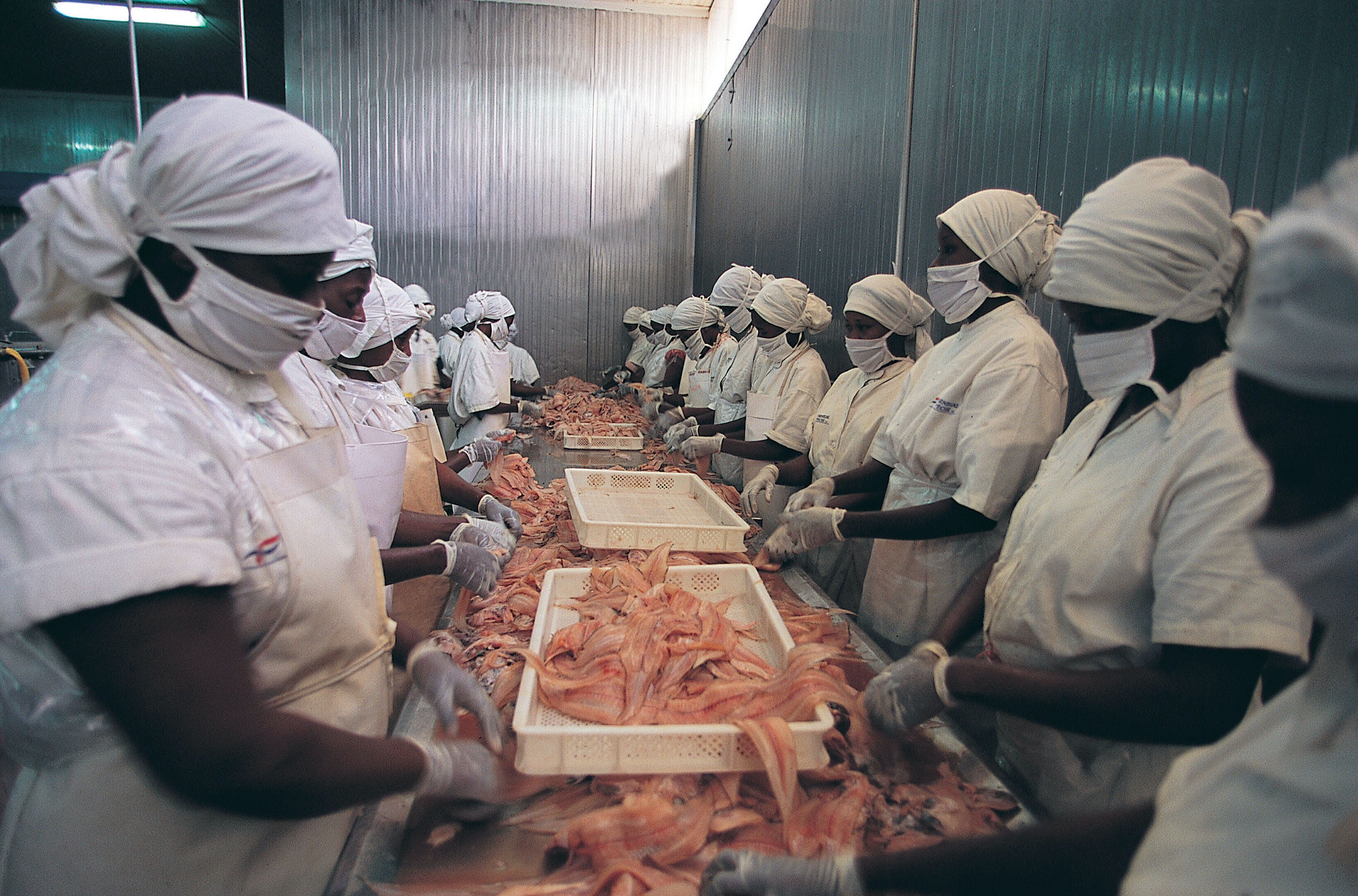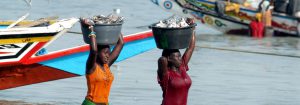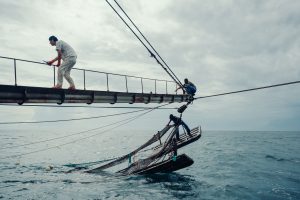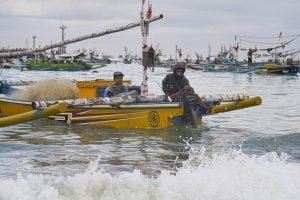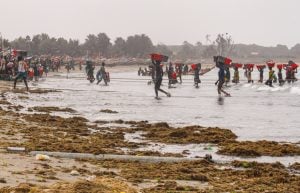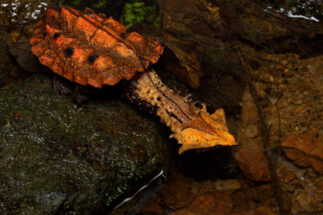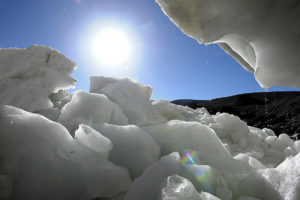Gunjur Beach lies an hour’s drive from the Gambian capital of Banjul, along a stretch of wide open road and dirt tracks with few cars. In this West African coastal village, small-scale fishing is the bedrock of life. There are fishers, haulers, net menders, boat builders, fish driers. And they are all men.
To get a fuller picture of who contributes to this fishery, you have to walk past the landing sites, right to the back of the beach. Here, you’ll find the women, singing as they slice, dice and prepare freshly caught fish, which will later be sold or smoked on large grills loaded with firewood. Young children play in the sand and some women have babies swaddled to their backs.
Gunjur is emblematic of the often hidden nature of women’s work in the fishing industry more globally. Of the 113 million people who work in small-scale and subsistence fishing, about 45 million are women, according to the latest assessment by the UN Food and Agriculture Organization (FAO).
Policy design, however, doesn’t properly consider women. The FAO assessment found that the majority of countries failed to collect gender-specific data that properly reflected women’s roles in official statistics, and that women were largely unaccounted for in government schemes to help out the sector, such as social security benefits.
There are of course many roles in the fishing industry. The FAO notes that more men are recorded as fishers than women. As for gleaning – catching seafood in shallow coastal waters, often by hand – women carry out more of this activity than men, the FAO found in another report. In aquaculture, women are estimated to account for 70% of the total workforce.
“The fact that they are not the fishers, or the fish that they catch is not counted because it goes directly to feeding the family or are sold to neighbours… are just some of the things that makes the role of women almost invisible,” explains Dr Ifesinachi Okafor-Yarwood, a lecturer in sustainable development at the University of St Andrews, Scotland.
A 2021 study examined how gender influenced roles in the small-scale lake fisheries of Malawi, East Africa. Jobs that could be “done by anyone” were often assigned to women – namely carrying and processing fish. They were considered not to have the strength or know-how to fill more visible roles such as captaining a boat or being part of a commercial fishing fleet.
In Nigeria, women not only sell the fish but are involved in net-mending and provisioning for fishing trips. This work often goes unrecognised, and the result is that women are often overlooked when it comes to policy decisions that would ultimately benefit them, says Okafor-Yarwood.
In Asia, as in Africa, subsidies for fishers are normally passed on through boat registrations. Yet nearly all the boats are owned by men. “People who do not own boats do not become members [of fishing associations],” says Okafor-Yarwood. “So it is very important that women are also considered as fishers and included in these associations, and also in discussions with the government on fisheries management.”
In Indonesia, it is commonly understood that women are prohibited from going out on boats to fish. Yet some women, for example in Bitung, Northern Sulawesi, have been fishing for decades. The fish they catch are mixed with fish landed by their husbands or other “official” male fishers – and the men claim the benefits. The US Agency for International Development (USAID) has been trying to tackle this by helping women to formally register as fishers.
“Women are not really considered ‘real’ fishers,” says Kyoko Kusakabe, a gender and development studies professor at the Asian Institute of Technology in Bangkok, Thailand. “We consider that a problem.”
Casting a wider net for sustainable fishing
Asia and Africa are particularly blessed with mangrove forests. These havens for small marine species are critical to around 893,000 small-scale fishers in Indonesia alone. In Bangladesh and Nigeria, an estimated 82% and 89% of fishers work predominantly in and around mangroves.
These coastal trees also absorb and store carbon dioxide in their roots and branches. In fact, they can store up to 10 times more carbon per hectare than terrestrial forests.
Globally, mangroves are being cleared at a rate of 1–2% a year to make way for fish farms, rice paddies, rubber and oil palm plantations, and other forms of agriculture. More than 21,000 hectares of mangroves have been lost per year over the last decade.
At dawn in The Gambia, women regularly head out in small boats then wade through the mangroves of the Gambia River on the hunt for oysters to sell in markets, and to feed their families with. In this country, the oyster trade is entirely run by women. Yet women get scant recognition for their stewardship role.
“The women are the ones who protect the mangroves. They have a lot of knowledge about mangroves and so we are missing out on all this important information, and the catch in that area, by not really considering women in this context and then also trying to protect their activities,” says Kusakabe.
There are other areas too where accounting for women could lead to more sustainable fishing management. For example, in Tanzania, the octopus fishery was dominated by women until it began to be commercialised and men took over. Women attributed the decline in their catch to men diving in deeper waters that had historically provided a refuge for the species. If women had been considered, the practice of catching octopus in deeper waters could have been better managed by government authorities.
Back in Gunjur, The Gambia, women have increasingly been sidelined since a fishmeal factory opened up in 2016. Men were selling bonga, the cheapest fish available, directly to the fishmeal factory, bypassing the women who usually supply the country’s markets and households. The factory paid higher fees for the catch and ground it up to be shipped and fed to farmed animals abroad. Women did not have the buying power to compete with the factory and, as a result, the amount of fish available to local markets fell and the price rose.
Covid-19 support package skips women
There are also instances where sustainable fishing policies can be detrimental to the activities of women, and lawmakers need to consider how women can be brought on board or cushioned from such impacts. In El Salvador, community leaders imposed a ban on estuary fishing because of depleted breeding grounds. This mainly affected women, whose activities were limited to the coastline and estuaries.
“Where women are missing out, and where they actually dominate, is the post-harvest sector,” says Kafayat Fakoya, a senior lecturer in the fisheries department of Lagos State University. “Most of the policies have concentrated on enhancing the viability of the harvest sector.” Fakoya was involved in a report by the FAO looking at the contributions of those that are overlooked in conventional data on small-scale fishing.
“There is far less research on women’s activities. Most is done on what is related to ‘real fishing,’” echoes Kusakabe. “We have a lot of gaps in terms of looking at fishing from a gender perspective.”
Cristina Pita is a specialist in small-scale fisheries and principal researcher in sustainable markets at the International Institute for Environment and Development (IIED). She believes the invisibility of women working within the industry results in under-representation in fisheries organisations and other decision-making bodies “Ultimately, these inequities increase the vulnerability of women to shocks and stressors, such as climate impacts, natural disasters, the Covid-19 pandemic, overfishing,” she adds.
In Ghana, women not only work in the fish-processing sector, some are also involved in the micro credit industry that lends money to fishers so they can buy provisions for their trips. Last year, when Ghana closed fishing for a month because of Covid-19, authorities made efforts to supply rice and oil to boat owners and their crew. Women in the value chain were not considered. Ghana enforced the same fishing ban this year, but there was an outcry. As a result, both men and women were helped to subsidise their income through food handouts.
Fishing experts emphasise that women’s contribution to the fishing sector needs to be better researched and documented. “If people are not talking about it, then governments will not necessarily be thinking about [women] when making these policies,” says Okafor-Yarwood.
Part of the reason why they are often missed out in the data is the informality of their work in the sector. And, as in The Gambia, researchers in Ghana often head out to the landing site, but do not venture beyond to talk to women where they are based.
Governments are not blameless. Okafor-Yarwood says there are more women working throughout the fishing value chain than current numbers show. But to form a comprehensive view “would mean bad news for policymakers because it would mean more people that you are not catering for.” It is in the interests of government not to get the full picture, she adds.
In Mexico, many women working in the small-scale fishing sector were also unable to access Covid-19 stimulus packages provided by their government. Official tallies estimate that only 8% of fishers in Mexico are women, but experts suggest this is a significant underestimate. Women mend their husband’s fishing equipment, paint buoys, process catch for billing, handle marketing and sales, as outlined by the Walton Family Foundation. Yet government policies only cater for their husbands. Women have had to find alternative ways of coping with a sharp drop in their income, including by offering door-to-door seafood sales.
A study by Community and Biodiversity (COBI), a Mexican civil society organisation, concluded that “The change in family dynamics due to lockdown has also affected women’s health and overall community wellbeing. Increases in violence against women within families have been reported.”
Why women are exploited and abused
Women face myriad challenges working in a sector still traditionally considered the domain of men. They are often excluded from financial and other support from state institutions, notes Okafor-Yarwood. They may not have enough money to be able to set up their own fishing business, or they face harsher shocks from global disruptions to the market. This limits income security and makes them more vulnerable to risky forms of maintaining employment. In Ghana, when young girls or women could not afford to buy fish from fishermen to sell in the markets, some engaged in transactional sex to get fish to trade. Fishing communities in Africa and elsewhere have higher HIV infection prevalence rates than the national average, due to issues such as transactional sex, notes Okafor-Yarwood.
Very little is also known about existing market structures that limit financial benefits for coastal communities. “One of the problems is that seafood products tend to be stocked and sold together,” says Pita from IIED. She says much of the catch from small-scale fisheries in developing economies, especially high-value seafood, ends up in developed nations, without the origin being disclosed.
In Thailand, where the seafood industry is heavily dependent on migrant workers, women are often assigned the most unstable and poorly paid positions, the International Labour Organization found. Some 73% of men were paid the minimum wage or more, while only 48% of women were. Women were also more at risk of forced labour abuses by managers who withheld their identity documents.
Tackling the exploitation of women will require governments to actively educate employers and male family members on the value that women create in small-scale fishing. They need to learn “how this can be leveraged if female fish workers are provided with job security and higher working conditions,” explains Anna Ducros, a researcher in inclusive economies at IIED.
“In order to bring gender to the forefront of government efforts, it is necessary to gain a deeper understanding of where value and profit is created by women across the small-scale fisheries value chain through further research,” Ducros adds. “Governments can call for and support this undertaking and facilitate or fund research that takes a gender approach.”
Naming and shaming governments could also mean women are better included in data collection and therefore in government policies, for example, in the provision of food aid to fishing communities and subsidies in general, as was the case in Ghana.
Experts say the solution is to look at fishing from a wider lens of people’s livelihoods. “Fishing is a very volatile occupation; the income can be very good, then it can be very bad,” says Kusakabe. “Women are the ones who do much other work in order to smooth out this income,” she says, referring to women taking up jobs in other sectors during the low season.
Governments need to support women to get fairer access to the fishing sector, so they can easily buy, catch and sell fish without suffering unfair labour practices and sexual exploitation. It is also important that women have access to affordable credit. Financial organisations could be established, such as credit unions, banks and cooperatives, that specifically provide loans at affordable rates to women, says Okafor-Yarwood.
Ultimately, explains Kusakabe, fisheries management should collect data on all non-fishing activities, such as descaling and washing fish or making nets, to give us “a better understanding of the fisheries community” and women’s role within it.


